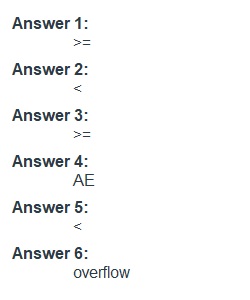


Q Question 8 2.4 / 2.8 pts Convert -58 to its 14-bit binary equivalent. Show your answer in the positional notation. Then convert the bit pattern to hexadecimal by filling the Hex digit row. • Step 1: Find the least power of 2, 2s ?| |. s = . • Step 2: Fill position up to with the sign bit. o Fill up to 4 bits in a blank. o Fill unnecessary blanks with NA. • Step 3: Fill the unsigned binary equivalent of + 2s = in the positional notation. • Step 4: Fill the necessary empty spots with 0. Position 15 down to 12 11 down to 8 7 down to 4 3 down to 0 Bit Hex digit Question 9 1 / 2 pts Extend signed 12-bit 0x55E to a 20-bit representation. Then convert the extended pattern to its hexadecimal representation. • Fill unnecessary blanks with NA. Position 19 ~ 16 15 ~ 12 11 ~ 8 7 ~ 4 3 ~ 0 12-bit original Extended 20-bit Hex of the extended 0x Question 10 1.4 / 2 pts Extend signed 14-bit 0x29AF to a 17-bit representation. Then convert the extended pattern to its hexadecimal representation. • Fill unnecessary blanks with NA. Position 19 ~ 16 15 ~ 12 11 ~ 8 7 ~ 4 3 ~ 0 14-bit original Extended 17-bit Hex of the extended 0x Question 11 1.2 / 1.2 pts Negate the 7-bit pattern 0x68. • Fill the binary representation of the original pattern in the Original row. • Fill the resulting bit pattern of NOT operation in the NOT row. • Fill the final negated bit pattern in the Negated row. Position 7 ~ 4 3 ~ 0 Original NOT Negated Question 12 1.2 / 1.2 pts Negate the 8-bit pattern 0xC8. • Fill the binary representation of the original pattern in the Original row. • Fill the resulting bit pattern of NOT operation in the NOT row. • Fill the final negated bit pattern in the Negated row. Position 7 ~ 4 3 ~ 0 Original NOT Negated Question 14 3 / 3 pts Assume A and B are 8-bit registers, A = 0x5D and B = 0xAF. Both A and B are treated as signed numbers. Calculate A ? B. Is there overflow? Justify. Step 1: A 0 and B 0. (Fill >= or < in both boxes) Step 2: The expected result of A ? B is 0. (Fill >=, <, or either >= or < in the box) Step 3: A ? B = 0x that is 0. (Fill the hexadecimal representation of the result in the 1st box) (Fill >= or < in the 2nd box) Step 4: There is . (Fill overflow or no overflow in the box)
View Related Questions